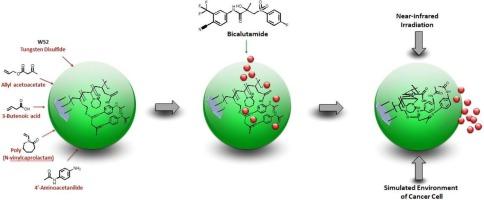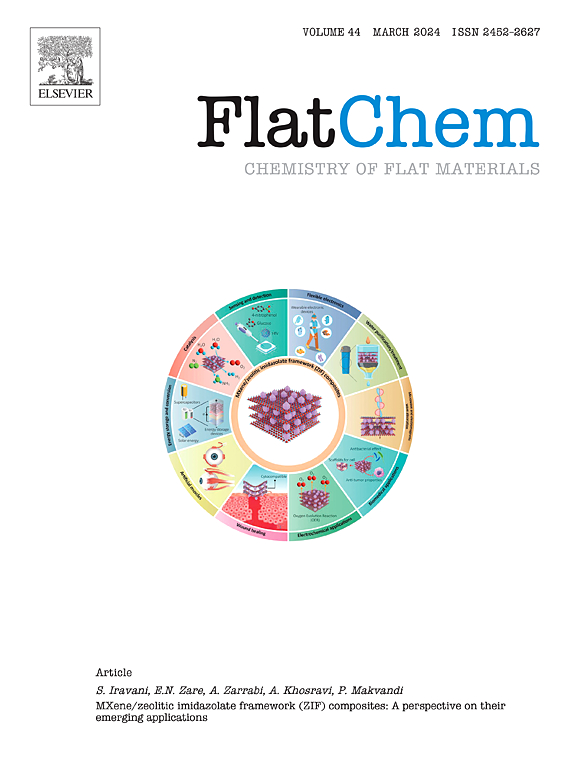聚(N-乙烯基己内酰胺)和乙烯基乙酸对 WS2 纳米片的表面功能化,用于前列腺癌的靶向药物释放
IF 6.2
3区 材料科学
Q2 CHEMISTRY, PHYSICAL
引用次数: 0
摘要
刺激响应型纳米载体能够提高治疗效果并最大限度地减少药物的脱靶效应,因此作为一种有前途的策略在癌症治疗领域备受关注。本研究介绍了一种对 pH 值和近红外(NIR)光敏感的新型纳米聚合物,作为一种智能载体将比卡鲁胺(BCT)输送到癌细胞中。为此,在二硫化钨(WS2)纳米片表面改性了温度响应型(聚 N-乙烯基己内酰胺)和 pH 值敏感型(乙烯基乙酸)聚合物,然后使用 TGA、FE-SEM、XRD 和 FT-IR 技术对其进行了表征。实验变量包括 pH 值(5.56)、温度(25 °C)和接触时间(11.02 分钟),采用响应面方法学(RSM)和中央复合设计(CCD)进行了优化,吸附效率达到 99.45%。利用相关系数(R2)和几种统计误差函数(包括平均相对误差(ARE)、均方根误差(RMSE)、混合分数误差函数(HYBRID)和卡方检验(χ2))分析了 RSM-CCD 模型的能力。体外药物释放程序在不同的 pH 值(5.6 和 7.4)和温度(37 和 50 °C)下进行了评估。结果表明,在 50 °C、pH 值为 5.6 的条件下,6 小时内 BCT 的最大释放率为 87.2%,而在 37 °C、pH 值为 7.4 的条件下,释放率为 13.3%。此外,在 pH 值为 5.6 的条件下,经过 10 分钟的近红外照射后,负载 BCT 的载体显示出完全的 BCT 释放(100%)。动力学数据证实,最佳拟合属于零阶模型,药物释放遵循超ase II 运输机制。本文章由计算机程序翻译,如有差异,请以英文原文为准。

Surface functionalization of WS2 nanosheets with Poly(N-vinylcaprolactam) and vinylacetic acid for targeted drug release in prostate cancer
Stimuli-responsive nanocarriers have gained attention in cancer therapy as a promising strategy because of their ability to enhance treatment efficacy and minimize off-target medication effects. This study introduces a novel nanopolymer responsive to pH and near-infrared (NIR) light as an intelligent carrier for delivering bicalutamide (BCT) into cancer cells. For this, the surface of tungsten disulfide (WS2) nanosheets is modified with temperature-responsive (poly(N-vinylcaprolactam)) and pH-sensitive (vinylacetic acid) polymers and then characterized using TGA, FE-SEM, XRD, and FT-IR techniques. Experimental variables including pH (5.56), temperature (25 °C), and contact time (11.02 min) are optimized using response surface methodology (RSM) and central composite design (CCD), yielding an adsorption efficacy of 99.45 %. The RSM-CCD model’s capability is analyzed using the correlation coefficient (R2) and several statistical error functions, including average relative error (ARE), root mean square error (RMSE), hybrid fractional error function (HYBRID), and Chi-square test (χ2). The in vitro drug release procedure is evaluated at different pH levels (5.6 and 7.4) and temperatures (37 and 50 °C). The results showed a maximum BCT release of 87.2 % within 6 h at 50 °C and pH 5.6, compared to 13.3 % at 37 °C and pH 7.4. Moreover, the BCT-loaded carrier demonstrates complete BCT release (100 %) following 10 min of NIR irradiation at pH 5.6. The kinetic data confirm that the best fit belongs to the zero-order model, and the drug release followed the supercase II transport mechanism.
求助全文
通过发布文献求助,成功后即可免费获取论文全文。
去求助
来源期刊

FlatChem
Multiple-
CiteScore
8.40
自引率
6.50%
发文量
104
审稿时长
26 days
期刊介绍:
FlatChem - Chemistry of Flat Materials, a new voice in the community, publishes original and significant, cutting-edge research related to the chemistry of graphene and related 2D & layered materials. The overall aim of the journal is to combine the chemistry and applications of these materials, where the submission of communications, full papers, and concepts should contain chemistry in a materials context, which can be both experimental and/or theoretical. In addition to original research articles, FlatChem also offers reviews, minireviews, highlights and perspectives on the future of this research area with the scientific leaders in fields related to Flat Materials. Topics of interest include, but are not limited to, the following: -Design, synthesis, applications and investigation of graphene, graphene related materials and other 2D & layered materials (for example Silicene, Germanene, Phosphorene, MXenes, Boron nitride, Transition metal dichalcogenides) -Characterization of these materials using all forms of spectroscopy and microscopy techniques -Chemical modification or functionalization and dispersion of these materials, as well as interactions with other materials -Exploring the surface chemistry of these materials for applications in: Sensors or detectors in electrochemical/Lab on a Chip devices, Composite materials, Membranes, Environment technology, Catalysis for energy storage and conversion (for example fuel cells, supercapacitors, batteries, hydrogen storage), Biomedical technology (drug delivery, biosensing, bioimaging)
 求助内容:
求助内容: 应助结果提醒方式:
应助结果提醒方式:


